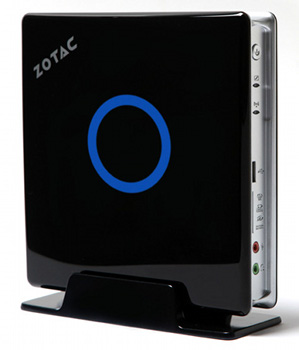Mini PC includes Ion 2 graphics, dual-core Atom
Mar 5, 2010 — by LinuxDevices Staff — from the LinuxDevices Archive — 14 viewsZotac announced a mini-PC incorporating Intel's dual-core Atom D510 and Nvidia's “Ion 2” GPU (graphics processing unit). The Zbox HD-ID11 includes both HDMI and dual-link DVI graphics outputs, wired and wireless networking, six USB 2.0 ports, an eSATA port, and a bay for a 2.5-inch hard disk drive.
The Zbox HD-ID11 appears to be one of the first devices to use Nvidia's second-generation Ion GPU, which has become informally known as the "Ion 2" even though the chipmaker doesn't use that moniker itself. Revised to work with the "Pineview" Atoms, including the N450, D410, and D510, Ion 2 was announced in December, and is claimed to provide more than ten times the performance of Intel's integrated graphics. (See later in this story for background.)

Zotac's Zbox HD-ID11
(Click to enlarge)
In addition to 512MB of dedicated DDR3 video memory, the Zbox HD-ID11 has a single SODIMM slot for DDR2 RAM (the maximum is likely 2GB, though Zotac didn't specify). It employs a dual-core Atom D510 CPU clocked at 1.66GHz, paired with Intel's NM10 I/O controller, the company adds.
The 7.4 x 7.4 x 1.3 inch device is said to have room for a 2.5-inch SATA HDD (hard disk drive), and also to feature an eSATA connector on its rear panel (below) for connecting external HDDs. Other rear-panel ports include four USB 2.0 ports, gigabit Ethernet, a S/PDIF digital audio connector, plus both HDMI and dual-link DVI outputs, Zotac says.

The rear panel of Zotac's Zbox HD-ID11
(Click to enlarge)
According to Zotac, the Zbox HD-ID11's front panel has another USB 2.0 port — supplemented by a sixth such port on top of the machine — along with a microphone jack, headphone jack, and a "6-in-1" card reader. It's said the mini-PC also includes 802.11b/g/n wireless networking.
Features and specifications listed by Zotac for the Zbox HD-ID11 include:
- Processor — Intel Atom D510 clocked at 1.66GHz
- Chipset — NM10
- Memory — single SODIMM slot (unpopulated) for DDR2 RAM
- Storage — internal bay for 2.5-inch SATA HDD (plus eSATA port)
- Expansion — MMC/SD/SDHC/XD/Memory Stick/Memory Stick Pro card reader
- Networking:
- LAN — gigabit Ethernet
- WLAN — 802.11b/g/n
- Other I/O:
- 6 x USB 2.0 (4 on rear, 1 on front, 1 on top)
- S/PDIF output (type n/s, but optical presumed)
- dual-link DVI (supports VGA with adapter)
- HDMI
- eSATA
- Audio — mic in and headphone/line out
- Power consumption — n/s
- Dimensions — 7.4 x 7.4 x 1.73 inches (188 x 188 x 44mm)
Nvidia's Ion and Ion 2
 Intel's Atom processor was originally designed to use the chipmaker's own northbridge and southbridge chips, which weren't designed with gaming or HD video playback in mind. In December 2008, Nvidia responded by announcing its Ion platform (pictured at right on a development board), which used an Atom CPU, but jettisoned the rest of Intel's chipset in favor of a single northbridge/southbridge companion chip that includes a GeForce 9400 GPU.
Intel's Atom processor was originally designed to use the chipmaker's own northbridge and southbridge chips, which weren't designed with gaming or HD video playback in mind. In December 2008, Nvidia responded by announcing its Ion platform (pictured at right on a development board), which used an Atom CPU, but jettisoned the rest of Intel's chipset in favor of a single northbridge/southbridge companion chip that includes a GeForce 9400 GPU.
Nvidia says Ion-based products can have DDR3 memory interfaces with frontside bus speeds of up to 1066MHz. Graphically, they're said to support DirectX 10, offer resolutions up to 2560 x 1600 pixels, provide 1080p HD video playback, and deliver HDMI, VGA, DisplayPort, and dual-link DVI video outputs.
As long ago as May 2009, however, Intel leaked word of its new "Pine Trail" chipset, which would bring the Atom's memory controller and graphics core on-die. This raised several questions: First, would the performance boost provided by the Ion be necessary any longer, and, second, could Nvidia make its product compatible with Intel's new platform?
Now, of course, Pine Trail has been released, including the "Pineview" Atoms mentioned earlier along with the NM10 I/O controller. While these new "kits" feature lower power consumption and somewhat better graphics, the Ion — even in its original version — provides much better OpenGL performance and HD video playback, according to published benchmarks.
As to whether the Ion could work with Pine Trail, Nvidia allowed rumors to circulate about an "Ion 2," but apparently couldn't commit itself fully until it got a closer look at the new CPUs. Last December, though, the chipmaker announced that the next-generation Ion, compatible with Pine Trail, would ship early this year.
Other than to tout Pine Trail compatibility, Nvidia hasn't publicly explained any technical differences between the original Ion and the next-generation version that's now shipping. However, "Ion 2" is said to be compatible with the company's Optimus technology. As explained in a WindowsForDevices story, here, Optimus consists of special Windows 7 drivers (plus a matching control panel) that can save battery power by switching to discrete graphics only for games and other selected applications.
Availability
Zotac did not cite pricing for its Zbox HD-ID11, but the device — offered in a bare-bones configuration with no onboard RAM, HDD, or OS — appears to be available now from a variety of online resellers in the U.K. More information may be found on the Zotac website, here.
According to an item on the Hot Hardware website, here, the Abox HD-ID11 will sell in the U.S. for approximately $210.
This article was originally published on LinuxDevices.com and has been donated to the open source community by QuinStreet Inc. Please visit LinuxToday.com for up-to-date news and articles about Linux and open source.